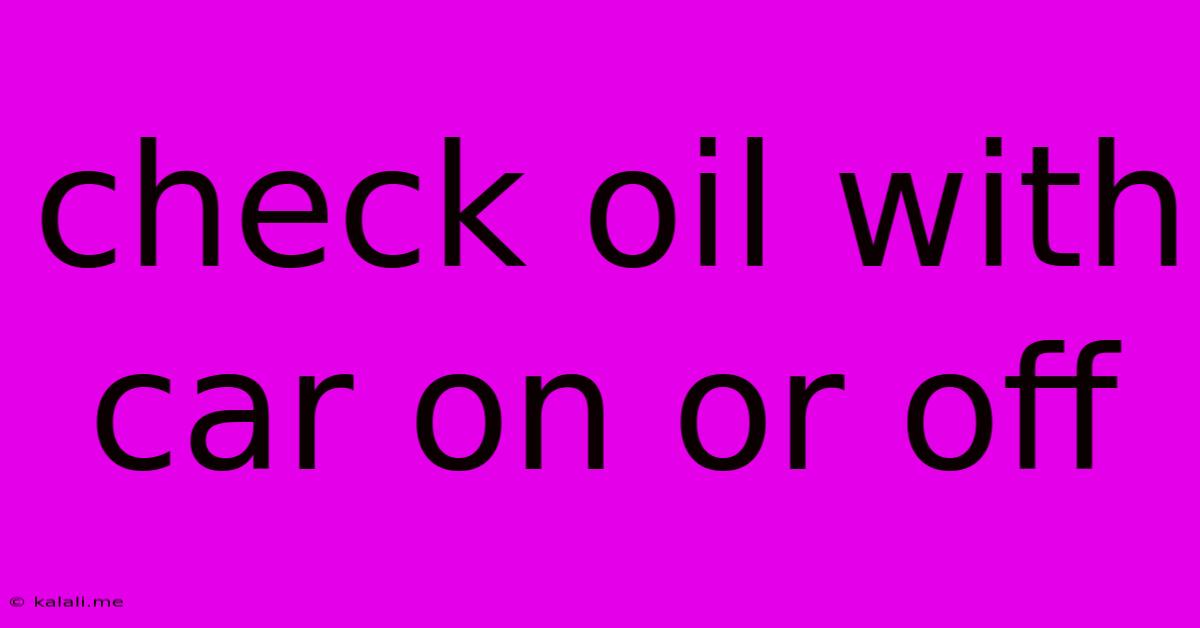Check Oil With Car On Or Off
Kalali
May 24, 2025 · 3 min read

Table of Contents
Checking Your Car's Oil: Engine On or Off?
Knowing when to check your engine oil is crucial for maintaining your vehicle's health and longevity. Many drivers wonder whether it's safer and more accurate to check their oil with the engine running or switched off. The short answer? Always check your oil level with the engine OFF and after allowing it to sit for a few minutes. This ensures an accurate reading and prevents potential burns or injuries. This article will delve deeper into the reasons why.
Why You Should Never Check Your Oil with the Engine Running
Checking your oil level with the engine running is incredibly dangerous and inaccurate for several reasons:
-
Risk of Burns: Hot oil under pressure can cause severe burns if it splashes or spills. Even a small amount of hot oil can cause significant damage to your skin. Your engine block and oil components are incredibly hot when running, increasing the risk significantly.
-
Inaccurate Reading: With the engine running, the oil is circulating throughout the system. This makes it nearly impossible to get an accurate reading on the dipstick. Some oil will still be in the engine block and oil lines, leading to an artificially low reading.
-
Moving Parts: A running engine has many moving parts. Getting near a running engine increases the risk of accidental injury from moving belts or other components.
The Correct Way to Check Your Engine Oil
Checking your oil correctly is a simple process that should be done regularly as part of your vehicle maintenance routine:
-
Safety First: Ensure your car is parked on a level surface and the engine is completely off. Allow the engine to sit for at least 5-10 minutes to allow the oil to fully drain back into the oil pan. This ensures an accurate measurement.
-
Locate the Dipstick: Open your hood and locate the dipstick. It usually has a bright colored handle (often yellow or orange) and is clearly marked with "oil" or has an oil can symbol.
-
Remove and Wipe: Remove the dipstick, wipe it clean with a lint-free cloth, and reinsert it fully back into the tube.
-
Check the Level: Remove the dipstick again. The oil level should be between the minimum and maximum marks. If the oil is below the minimum mark, you need to add more oil. If it's above the maximum mark, you may have overfilled the engine, requiring some oil to be drained.
-
Add Oil (If Necessary): If you need to add oil, do so slowly and carefully, checking the dipstick again after adding small amounts. Consult your owner's manual for the correct type and amount of oil for your vehicle. Using the incorrect oil can damage your engine.
Understanding Oil Levels and What to Do if Low
Maintaining the correct oil level is vital for engine health. Low oil levels can lead to engine damage and costly repairs. Regular oil changes and checks are key to preventing problems.
Signs of Low Oil:
- Oil light on the dashboard: This is a critical warning sign indicating extremely low oil levels. Stop driving immediately and add oil.
- Unusual engine noises: Knocking, ticking, or rattling sounds could indicate insufficient lubrication.
- Reduced engine performance: Loss of power or difficulty starting the engine may also suggest low oil.
If your oil level is consistently low, you may have an oil leak. Consult a qualified mechanic to diagnose and repair the leak promptly.
By following these steps and remembering to always check your oil with the engine off, you'll ensure accurate readings and maintain the health of your engine, contributing to longer engine life and preventing costly repairs. Remember to consult your owner's manual for specific recommendations for your car model.
Latest Posts
Latest Posts
-
What Time Does The Orlando Airport Open
May 24, 2025
-
Lock Washer And Flat Washer Order
May 24, 2025
-
How To Scp From Local To Remote
May 24, 2025
-
How Could You Switch The Polarity Eleectromagnet
May 24, 2025
-
How To Tell If A Road Is Private Or Public
May 24, 2025
Related Post
Thank you for visiting our website which covers about Check Oil With Car On Or Off . We hope the information provided has been useful to you. Feel free to contact us if you have any questions or need further assistance. See you next time and don't miss to bookmark.